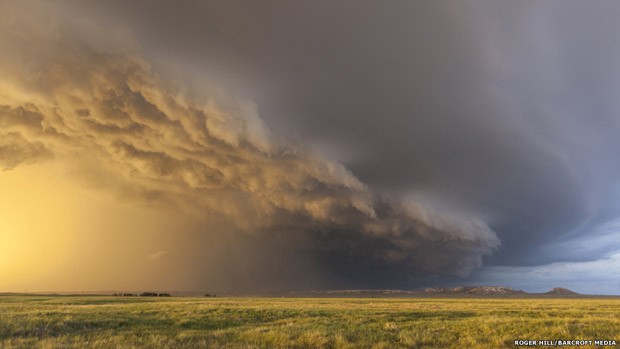Uma equipe de pesquisadores dirigida por Chang-Hoi Ho, professor da Universidade Nacional de Seul, analisou cinco séries de dados de ciclones tropicais observados no noroeste do Pacífico entre 1977 e 2010, no estudo publicado pela revista especializada "Environmental Research Letters".

Furacão, tufão e ciclone são nomes regionais para o mesmo tipo de tempestade (Foto: Roger Hill/Barcroft USA)
As costas de China, Coreia do Sul e Japão sofreram durante este período de 33 anos ciclones cada vez mais potentes, o que os cientistas atribuem a alterações na temperatura da superfície das águas oceânicas e à circulação de correntes de ar sobre as águas costeiras.
Segundo os pesquisadores, o sistema de circulação atmosférica de Walker, sobre o Pacífico, se reforçou com o aumento da diferença de temperaturas entre o oeste do oceano, mais quente, e as partes central e oriental, mais frias.
O estudo aponta que os ciclones têm maior tendência a avançar sobre as costas do Mar da China meridional e que ao atingir a costa nordeste da Ásia, acumulam maior energia do que o habitual.
No sudeste da Ásia, em países como Taiwan e Vietnã, o estudo não revelou mudanças significativas na intensidade dos ciclones.
Na região, os ciclones se formam muito perto da terra e acumulam energia suficiente para ter um impacto extremo.
Os pesquisadores se mostraram muito prudentes na hora de prever a evolução dos ciclones no futuro na região, destacando que são necessárias investigações complementares para identificar melhor a parte do Pacífico oeste ligada às variações naturais (como 'El Niño' e 'La Niña') relacionadas ao aquecimento global.
The warm waters of the Pacific Ocean has been accompanied over the past three decades , by increasingly strong cyclones that hit China, South Korea and Japan , according to a study published on Thursday ( 16 ) .
A team of researchers led by Chang - Hoi Ho , Professor of Seoul National University , analyzed five data sets of tropical cyclones observed in the Pacific Northwest between 1977 and 2010 , the study published by the journal " Environmental Research Letters ."
Hurricane , typhoon and cyclone are regional names for the same type of storm ( Photo: Roger Hill / Barcroft USA )
The coasts of China, Korea and Japan suffered during this 33 year period increasingly powerful cyclones , which scientists attribute the changes in surface temperature of ocean waters and the movement of air currents on coastal waters .
According to the researchers , the system of atmospheric Walker circulation over the Pacific , strengthened with increasing temperature difference between the western ocean, warmer , and , cooler central and eastern parts .
The study indicates that cyclones are more likely to move forward on the shores of the South China Sea and on reaching the northeast coast of Asia , accumulate more energy than usual .
In Southeast Asia , in countries such as Taiwan and Vietnam, the study revealed no significant changes in the intensity of cyclones.
In the region , cyclones are formed very close to the ground and accumulate enough to have an extreme impact energy.
The researchers were very prudent in time to predict the future evolution of cyclones in the region, highlighting that further investigations are needed to better identify the part of the western Pacific linked to natural variations (such as ' El Niño ' and ' La Niña ' ) related to global warming .
The warm waters of the Pacific Ocean has been accompanied over the past three decades , by increasingly strong cyclones that hit China, South Korea and Japan , according to a study published on Thursday ( 16 ) .
A team of researchers led by Chang - Hoi Ho , Professor of Seoul National University , analyzed five data sets of tropical cyclones observed in the Pacific Northwest between 1977 and 2010 , the study published by the journal " Environmental Research Letters ."
Hurricane , typhoon and cyclone are regional names for the same type of storm ( Photo: Roger Hill / Barcroft USA )
The coasts of China, Korea and Japan suffered during this 33 year period increasingly powerful cyclones , which scientists attribute the changes in surface temperature of ocean waters and the movement of air currents on coastal waters .
According to the researchers , the system of atmospheric Walker circulation over the Pacific , strengthened with increasing temperature difference between the western ocean, warmer , and , cooler central and eastern parts .
The study indicates that cyclones are more likely to move forward on the shores of the South China Sea and on reaching the northeast coast of Asia , accumulate more energy than usual .
In Southeast Asia , in countries such as Taiwan and Vietnam, the study revealed no significant changes in the intensity of cyclones.
In the region , cyclones are formed very close to the ground and accumulate enough to have an extreme impact energy.
The researchers were very prudent in time to predict the future evolution of cyclones in the region, highlighting that further investigations are needed to better identify the part of the western Pacific linked to natural variations (such as ' El Niño ' and ' La Niña ' ) related to global warming .
Nenhum comentário:
Postar um comentário